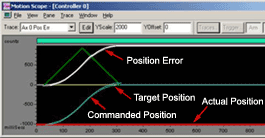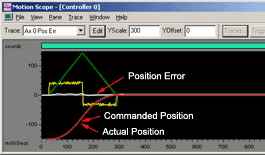Servo Tuning Basics
What is Tuning?
Servo Tuning Guidelines
What is a Servo?
Servo Algorithms: PID / PIV
The PID Algorithm and DRate
About PID PIDOutputOffset Parameter
Post Filter Theory
Specification Tips
Acceptable vs. Unacceptable Oscillations
Choosing Specifications for a Machine
Things to Consider
Comparison Table
Should I use PID or PIV?
Relation of Motor Object Offsets
to Filter Object Offsets
Comparing Different Move Times with
Different Under Damped Peaks
Tuning with Frequency Shaping
Tuning with Feedforwards
Converting PID Parameters to PIV Parameters

Before

After
Servo Tuning Techniques
PID
Overview
PID Parameter Definitions
How to Tune:
Step Behavior / Overshoot Criteria
Step Behavior / Stability Criteria
Under Damped / Over Damped
Scaling PID Tuning Parameters
PIV
Overview
PIV Parameter Definitions
How to Tune:
Monitoring Velocity Loop Performance
Tuning the Velocity Loop with Kpv, Kiv, Kpp
- Smoothing the Actual Velocity (Kpv)
- Applying the Velocity Loop Integral (Kiv)
- Applying the Position Loop Gain (Kpp)
Tuning the Velocity Loop with Kpv, Kpp, Kip
- Smoothing the Actual Velocity (Kpv)
- Applying the Position Loop Gain (Kpp)
- Applying the Position Integral Gain (Kip)
Feedforward Tuning
Overview
How to Tune:
Shape-based
- Acceleration Pattern (Kaff)
- Velocity Pattern (Kvff)
- Offset (Friction) Pattern (Kfff)
- Final Adjustments
Measurement-based
- Friction Feedforward
- Acceleration Feedforward
- Open Loop Feedforward
Frequency Shaping
Overview
How to Tune:
Frequency Shaping Tuning
Understanding/Reading Bode Plots
Mechanical Resonance
- Calculating Mechanical Resonance Frequencies
- Tuning a System with Mechanical Resonance





 本文详细介绍伺服系统的调校原理和技术,包括PID与PIV算法的应用、参数调整方法、频率整形及前馈调校等内容。适用于希望深入了解伺服系统工作原理及其调校技巧的专业人士。
本文详细介绍伺服系统的调校原理和技术,包括PID与PIV算法的应用、参数调整方法、频率整形及前馈调校等内容。适用于希望深入了解伺服系统工作原理及其调校技巧的专业人士。

















 被折叠的 条评论
为什么被折叠?
被折叠的 条评论
为什么被折叠?








